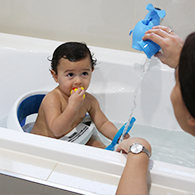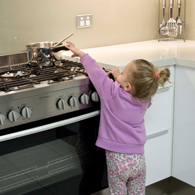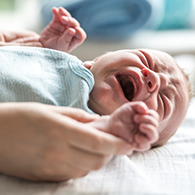Flammable clothing
What is flammable clothing?
Flammable clothing is clothing that catches alight and burns easily.
How are children injured?
Burns
If clothing catches fire while being worn, the wearer may suffer serious burns. Burn injuries can lead to permanent scarring, disability and even death. Children’s clothing that most commonly catch alight are pajamas and nighties.1
Clothing flammability is the speed at which the item catches fire and the rate at which it burns once alight. Flammability of clothing depends on a number of factors. These include2:
The type of fibre
- Cotton and rayon generally burn more easily.
- Synthetic fibres such as nylon are slower to ignite but once alight will melt and stick to skin.
- Protein based fabrics such as pure silk and pure wool, are more difficult to set on fire and slower to burn once ignited.
- Flame retardant fabrics are chemically treated to take longer to ignite. They will extinguish themselves once the flame source is removed. These are the types of fabrics fire fighters use.
Weave or weight
In general, heavier fabrics with a tighter weave have a higher flame resistance and are slower to burn.
Pile or nap
Pile or nap surfaces have very loose fibres, with air space between them e.g. fluffy and fuzzy fabrics, faux fur, chenille, corduroy, velvet and tassels. This type of surface ignites easily and the flames spread quickly across the fabric.
Clothing design
Long, loose fitting clothing, such as nightgowns, are more dangerous than close-fitting clothing, as they can swing away from the body and make contact with a flame.
How common are these injuries?
During 2009, forty-nine patients required treatment at one of the NSW SBIS Burn Units with burns related to flammable clothing.3
What are the laws, regulations or standards for flammable clothing?
From 1 January 2020, the Consumer Protection (Children’s Nightwear and limited daywear and Paper Patterns for Children’s Nightwear) Safety Standard 2017 became mandatory.
The standard applies to nightwear (and some daywear) from size 00 up to 14.1
Under the Consumer Protection Safety Standard, clothing must carry fire warning labeling according to its category. Clothing in Categories 1 -3 must carry a low fire hazard label and those in category 4 must carry a high fire hazard warning.
Remember:
Look for and choose sleepwear and clothing with low fire danger labeling for your child.
Choose close-fitting clothing instead of loose sleepwear and clothing which could catch alight easily.
Keep your child away from fires, radiators, heaters, BBQs, candles, lighters and matches.
Use guards around fires, radiators and heaters.
If you make your own children’s sleepwear and clothing, look at the safety warnings on patterns. Do not choose fabrics which are fluffy, fuzzy or have loose dangling tassels and avoid using lightweight material.
Teach your children to STOP, DROP, COVER face and ROLL so they know what to do if clothing does catch fire.
More information available at Kids Health | Burns & Scalds
References
1 Australian Competition and Consumers Commission – Product Safety Australia. (2019). Nightwear for Children. Accessed from https://www.productsafety.gov.au/standards/nightwear-for-children
2 Oglesbay, F. B. (1998) The flammable fabrics problem. Injury Prevention. 4:317-320.
3 NSW State wide Burn Injury Service (NSW SBIS). Submission to the House of Representatives House Standing Committee on Health and Ageing. 2010 https://www.aph.gov.au/Parliamentary_Business/Committees/House_of_Representatives_Committees?url=/haa/burnsprevention/subs.htm







